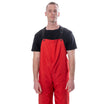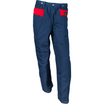Each year, countless construction projects continue on through the unpredictability of seasonal weather. Construction workers face the rain, wind, and cold, and their protection depends on quality rain gear designed to safeguard them from these harsh conditions. More than a simple convenience, the right rain gear is pivotal in maintaining their safety, productivity, and morale. This article takes a deep dive into the world of tested and approved rain gear, highlighting its importance, the different types available, the key features to look for, the industry standards, and how to select the perfect rain gear based on construction workers' roles and working conditions. Stay tuned as we shed light on this essential aspect of construction safety.
Importance of Rain Gear in Construction
With the ever-present possibility of adverse weather conditions, it's crucial to equip construction workers with the necessary gear to brave the elements. This is especially imperative when it comes to rainy conditions, where the usual rubber boots may not be sufficient enough. For this reason, rain gear is an essential part of a worker’s attire on a construction site. In this section, we'll delve into the various advantages this gear has to offer.
Protection Against Weather
Rain and other harsh weather conditions are often a hindrance in the construction industry. Workers have to deal with cold conditions, wet surfaces and potential health risks associated with exposure to rainfall. However, with the right rain gear, these risks can be mitigated significantly.
- Waterproof clothing shields the worker from getting wet, and the chill factor that comes with it. This contributes to keeping body temperatures stable and reducing sickness.
- Insulated gloves keep the hands warm, enabling better grip and control over tools thus reducing the risk of mishandling equipment.
- Good-quality rain boots ensure that water doesn’t seep into the footwear, keeping the workers' feet dry and reducing the possibility of slipping on wet surfaces.
Safety Assurance
Every construction site is inherently laden with risk factors, and severe weather conditions can exacerbate them. A properly equipped workforce can mitigate those risks and prevent substantial down-time. Wearing appropriate rain gear on a stormy day is not just about comfort; it contributes substantially to safety assurance too.
- Hi-vis jackets over the rain gear can enhance visibility ensuring workers are seen clearly, reducing the possibility of accidents on site.
- Waterproof hard hats help in protecting the head from falling debris, and the rain liner ensures the worker's head stays dry.
- Rain suit reduces the risk of hypothermia in cold, rainy environments.
That's not all; by creating a safer working environment, appropriate rain gear also helps in boosting the workers' confidence and morale.
Increased Productivity
When workers are battling uncomfortable conditions, they're naturally less focused and more prone to making errors. In contrast, providing workers with suitable rain gear can help to boost their productivity, due to:
- Increased comfort, allowing workers to focus more on the task at hand.
- Reduced risk of injury leading to fewer work-related absences.
- Enhanced morale and confidence as they feel valued and cared for.
Remember, well-equipped employees are content and productive employees; a little rain shouldn't pour water on their dedication. So, the next time you see those ominous grey clouds, your team will be ready, wearing confidence as a raincoat.
In summary, the investment in proper rain gear for construction workers is a win-win situation for everyone. It ensures the workers' safety while helping them stay productive under challenging weather conditions. While we cannot control the weather, with the right protection, we can surely make it less of a nuisance. Paving the way for a more secure and efficient construction site starts one rain jacket at a time.
Types of Rain Gear for Construction Workers
When it comes to working in construction, dealing with inclement weather is often part and parcel of the job. However, getting caught in the rain unprepared can not only lead to discomfort but also pose potential safety hazards. That's why having the right rain gear is crucial. Today, let's dive into the various types of rain gear that construction workers can incorporate into their kit to stay dry and safe.
Rain Jackets
Let's start with the most common piece of rain gear - the humble rain jacket. A sturdy, water-proof rain jacket with breathable material can make all the difference in a downpour. Look for jackets that feature a durable water repellent (DWR) coating and tapped seams. These jackets not only keep you dry from the rain but also prevent internal moisture build-up, ensuring you remain comfortable throughout your workday.
Rain Pants
Next in line are rain pants. Like the jackets, they should also feature a DWR coating to stop water penetration. The best rain pants for construction work will have adjustable waistbands for a comfortable fit and reinforced knees for durability. More importantly, make sure the pants have side access pockets so you can reach your regular pants underneath without trouble.
Full Rain Suits
When your working conditions involve long hours in heavy rain, opting for full rain suits is a wise choice. Providing head-to-toe protection, these suits come with jackets and pants that you wear over your regular work clothes. Full rain suits can offer an added layer of protection compared to separate pieces, making them highly effective for keeping workers dry during torrential rainfall.
Water-proof Boots
Keeping your feet dry in the midst of the rain is of paramount importance. After all, the last thing anyone wants to deal with is squelchy boots and wet socks! Investing in a pair of water-proof boots that are also slip-resistant is a prudent move. Not only will they help avoid unpleasant foot conditions such as athlete's foot, but their anti-slip trait also ensures that you maintain your balance on wet and slippery surfaces.
Water-proof Gloves
Construction work demands dexterity, making it imperative to have dry hands. Water-proof gloves should be part of your rain gear arsenal. Look for gloves made with materials such as neoprene or GORE-TEX, famed for their water-resistance capabilities. Additionally, consider gloves with a textured grip for handling tools securely in the rain.
Weather can be unpredictable, but your preparedness for it doesn't have to be. Equipping yourself with the right rain gear will ensure that even the heaviest downpour doesn't disrupt your workflow or compromise your safety. Stay ready, stay dry, and keep building!
Key Features of Tested and Approved Rain Gear
Staying dry during a torrential downpour or a mild drizzle starts with having the right gear. But what separates exemplary rain gear from the mediocre pack? Sure, they all repel water to some degree, but the best rain gear does much more. There are critical attributes you should look for when investing in such items. Read on to discover the key features of tested and approved rain gear that will keep your time in the rain as enjoyable as possible.
Weather Resilience
Resilience against various weather conditions is the backbone of top-quality rain gear. Whether you face light showers or heavy downpours, your chosen gear should protect you adequately. But the best rain wearables go the extra mile. Tested and approved rain gear also holds up well against wind and even some cold. Here are some important factors to consider:
- Waterproofing: The material should be fully waterproof, not just water-resistant. Fabrics such as rubber and nylon perform exceptionally in this aspect.
- Wind Resistance: Look for gear made with windproof material. Tightly woven fabrics often fit the bill.
- Cold resistance: Top-notch models also offer some level of thermal insulation, assisting during those cold, rainy days.
Durability
Imagine your rain gear coming apart during a storm because the material wasn't sturdy enough or the seams were poorly constructed. Sounds like a nightmare? It doesn't have to be.
Durability is key when it comes to choosing rain gear that can withstand elements. Here's what to keep an eye out for:
- Strong Fabrics: Heavy-duty materials like ripstop nylon or PVC ensure that your rain gear won't easily tear or get punctured.
- High-Quality Zippers: Opt for gear with heavy-duty, corrosion-resistant zippers to avoid usual wear and tear.
- Seam Construction: Look for rain gear with taped or weld-seamed to keep water from leaking in through the stitches.
Comfort
Comfort in rain gear doesn't just mean soft materials and a roomy fit. Great rain gear should breathe well, be lightweight, and easy to move in. Here are features that enhance comfort:
- Breathability: To avoid heating up during physical activities, go for gear with breathable fabrics, or constructed with venting solutions.
- Weight: Lighter gear is usually easier to carry around and move in, but ensure this doesn't compromise the other attributes.
- Flexibility: The gear shouldn't restrict your movement. Adjustable cuffs, roomy cut, and articulated joints can help provide flexibility.
When it comes to selecting rain gear, weather resilience, durability, and comfort are non-negotiable features. Your gear should protect you from the rain, last for a long time, and be comfortable enough for extended wear. Remember, don't just go after the first waterproof label you see; evaluate your needs and aim for the gear that ticks the main boxes. Your rainy day escapades will thank you for it.
Standards for Tested and Approved Rain Gear
What happens when the heavens open and a downpour ensues in the middle of your working day? From road construction workers to linemen, outdoor jobs often require durable, reliable rain gear that's not only waterproof but also conforms to particular standards.
American National Standard (ANSI)
Known globally for its certification of safety equipment, the American National Standard (ANSI) has a comprehensive array of guidelines that rain gear must conform to. This isn't something that won't cost safety officers their sleep, as many renowned manufacturers are already committed to meeting their stringent regulations.
Manufacturers focus on
- Visibility: ANSI-approved rain gear often has safe and high visibility colors, usually the conspicuous neon yellow or orange.
- Reflective accents: They are essential, particularly for those working during low-light conditions.
- Material durability: The gear is produced with long-lasting fabrics, continuously tested to withstand harsh weather conditions.
Occupational Safety and Health Administration (OSHA) Requirements
OSHA, another key player, sets forth an extensively detailed list of regulations regarding rain gear for construction and other outdoor operations. Don't be surprised to find many similarities between ANSI and OSHA requirements, one of the many reasons why the alliance between the two bodies is so crucial for workers' safety.
OSHA focuses on
- Protection: Rain gear used by employees in a construction site must adequately protect them from the elements to ensure their optimal comfort and productivity.
- Fit: Overly loose or tight-fitting rain gear can be a hindrance or even a safety hazard at the job site. OSHA requires that safety apparel, including rain gear, fits properly.
- Quality: The administration insists on the durability of the material, its suitability for the conditions, and its lifespan.
National Fire Protection Association (NFPA) Guidelines
When it comes to protecting against electrical hazards and work-related risks, the NFPA isn't left behind. They provide guidelines and standards for top-notch safety gear.
NFPA standards include
- Flame resistance: Rain gear designed for electrical and fire safety workers must be flame-resistant, a specification the NFPA is staunch about.
- Conductive components: NFPA guidelines reject any conductive components, including metal closures, on rain gear used by electricity workers.
- Quality: Like ANSI and OSHA, the NFPA also stress on the rain gear's durability, reinforcement on stress points, and its ability to withstand the respective occupational rigors.
And there you have it - the standards and regulations that rain gear must adhere to! From ANSI to OSHA, and NFPA, reliable rain gear embodies the features and guidelines prescribed by these organizations to ensure safety and usability in an array of working conditions.
Choosing the Right Rain Gear for Construction Workers
Working in construction is considered one of the most hazardous jobs that demand the utmost attention to safety precautions. This includes equipping workers with the best safety gear tailored to the circumstances at hand – one of the major ones being gloomy, rainy weather. Choosing the right rain gear becomes a decisive factor affecting the comfort, efficiency, and therefore safety of construction workers. But how do you select the right gear amid the numerous options available? Take into account the worker's role, working conditions, the durability of the gear, and its compliance with relevant standards.
Considering the Worker's Role
The first consideration in selecting appropriate rain gear caters to the role of the construction worker. Different tasks mandate different protective gear sets. For instance, a worker involved in heavy lifting may find bulkier, more durable gear helpful, while someone in a more supervisory role may prefer lightweight, easily portable gear.
- Heavy Duty Work: Highly protective and waterproof gear is paramount, taking precedence over even comfort.
- Supervisor Role: Consider rain gear that is lightweight and breathable but still offers enough protection.
Understanding the Working Conditions
Secondly, understanding the specific conditions that the worker will face is critical. These include the weather conditions specific to the location, the nature of the tasks, and the duration for which the worker will be exposed to the elements.
- Weather Specifics: The intensity of rain varies from light showers to torrential downpours. Accordingly, the choice of gear shifts from simple water-resistant wear to full-fledged waterproof gear.
- Task Nature: If the job involves a lot of movement, opt for rain gear made from flexible materials.
- Duration of Exposure: For ongoing, lengthy exposure to rain, it's better to opt for gear with high levels of water resistance and durability.
Evaluating the Gear's Durability
The longevity of the rain gear is an important aspect to factor in as well. Considering the severe conditions construction workers face, the gear needs to be durable enough to withstand harsh conditions without falling short.
- Quality of Materials: High-quality materials offer more resistance to wear and tear, increasing the gear's lifespan.
- Craftsmanship: Well-constructed gear is more durable.
Checking Compliance with Relevant Standards
Lastly, ensure that the rain gear complies with the standards laid down by authoritative bodies in your region. These ensure the gear's effectiveness in providing safe and sufficient protection.
- National and Local Standards: These standards dictate the minimum safety requirements rain gear should meet.
- Certifications: Look for gear that holds certifications from recognized safety organizations for assurance of their quality and standards.
To conclude, choosing the right rain gear for construction workers is not as simple as selecting the most expensive or the most popular option. It requires careful consideration of several factors, putting the comfort, safety, and efficiency of the worker at the forefront. By doing so, you'll contribute to a better working environment, ensuring protection against nature's fury in the form of relentless rains.
Conclusion
When it comes to the safety and productivity of construction workers, no stone can be left unturned. Weather conditions, a significant factor influencing safety at sites, should not be dismissed simply because they are beyond control. Instead, investing in robust, tested, and approved rain gear like waterproof jackets, pants, full suits, boots, and gloves can be an effective countermeasure.
In our comprehensive guide, we've highlighted factors to consider when buying this protective equipment, from understanding the worker's role and construction site conditions to evaluating gear durability and compliance with safety standards. These factors will aid in making an informed choice, ensuring that the gear enhances comfort, safety, and productivity.
And speaking of choices, at Hurricane Raingear, we offer an array of rain gear options that are not only 100% waterproof but also rip-resistant. Designed with the objective that you should remain dry without compromising on comfort, our gears also come equipped with reflective 3M striping for enhanced visibility. Trusted by thousands, our products aim to meet your every rain gear need - whether the result of drizzle or downpour. Visit our webpage to take one step forward in ensuring the safety and productivity of your construction workers today.
Frequently Asked Questions
-
What are the top rain gear options for construction workers?
The top rain gear options for construction workers are: 1. Waterproof jackets with reflective strips, 2. Waterproof pants or overalls, 3. Rubber or PVC rain boots, 4. Waterproof gloves, and 5. Waterproof hats or hoods.
-
Why is rain gear important for construction workers?
Rain gear is important for construction workers as it helps protect them from getting wet, which can lead to discomfort, distraction, and even health issues. It also improves visibility with reflective strips, reduces the risk of accidents, and keeps workers safe and productive.
-
What features should I look for in rain gear for construction workers?
When choosing rain gear for construction workers, look for features such as waterproof and breathable materials, high-visibility reflective strips, adjustable cuffs and hems, reinforced knees and elbows, multiple pockets, and durability to withstand the demands of the construction site.
-
Can rain gear for construction workers be used in all weather conditions?
While rain gear for construction workers is designed to withstand rain and wet conditions, it may not be suitable for extreme weather conditions such as heavy storms, extreme cold, or high winds. It's important to assess the specific weather conditions and choose the appropriate gear accordingly.
-
How do I ensure proper care and maintenance of rain gear for construction workers?
To ensure the longevity and effectiveness of rain gear for construction workers, it's important to follow the manufacturer's instructions for care and maintenance. This may include regular cleaning, drying, and storing the gear properly. Inspect the gear regularly for any damages or wear and replace as needed.





















Leave a comment
This site is protected by hCaptcha and the hCaptcha Privacy Policy and Terms of Service apply.